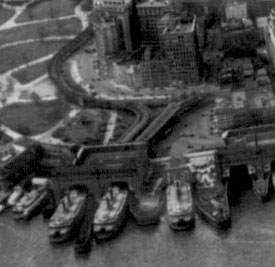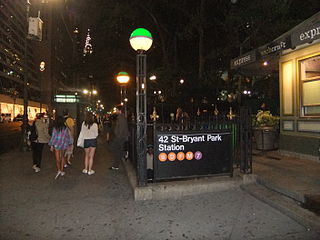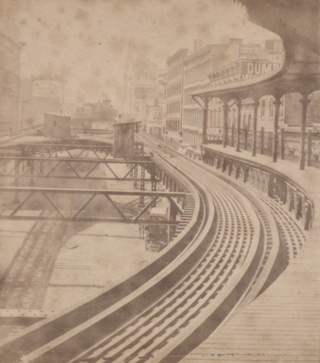Related Research Articles

The Interborough Rapid Transit Company (IRT) was the private operator of New York City's original underground subway line that opened in 1904, as well as earlier elevated railways and additional rapid transit lines in New York City. The IRT was purchased by the city on June 12, 1940, along with the younger BMT and IND systems, to form the modern New York City Subway. The former IRT lines are now the A Division or IRT Division of the Subway.

The 33rd Street station is a local station on the IRT Lexington Avenue Line of the New York City Subway. Located at the intersection of Park Avenue and 33rd Street in the Murray Hill neighborhood of Manhattan, it is served by 6 trains at all times, <6> trains during weekdays in the peak direction, and 4 trains during late night hours.

The Grand Central–42nd Street station is a major station complex of the New York City Subway. Located in Midtown Manhattan at 42nd Street between Madison and Lexington Avenues, it serves trains on the IRT Lexington Avenue Line, the IRT Flushing Line and the 42nd Street Shuttle. The complex is served by the 4, 6, and 7 trains at all times; the 5 and 42nd Street Shuttle (S) trains at all times except late nights; the <6> train during weekdays in the peak direction; and the <7> train during rush hours and early evenings in the peak direction.
The IND Sixth Avenue Line is a rapid transit line of the B Division of the New York City Subway in the United States. It runs mainly under Sixth Avenue in Manhattan, and continues south to Brooklyn. The B, D, F, and M trains, which use the Sixth Avenue Line through Midtown Manhattan, are colored orange. The B and D trains use the express tracks, while the F, <F> and M trains use the local tracks.

The Park Avenue Tunnel, also called the Murray Hill Tunnel, is a 1,600-foot-long (488 m) tunnel that passes under seven blocks of Park Avenue in Murray Hill, in the New York City borough of Manhattan. Traffic used to travel northbound from 33rd Street toward the Park Avenue Viaduct. The tunnel is under the jurisdiction of the New York City Department of Transportation. It is designed to carry one lane of northbound car traffic from East 33rd Street to East 40th Street. From 40th Street north, traffic must follow the Park Avenue Viaduct around Grand Central Terminal to 46th Street. The vertical clearance is 8 ft 11 in (2.72 m).

The South Ferry station was an elevated station at the southern terminal of the IRT Second, Third, Sixth and Ninth Avenue Lines. It was located next to Battery Park at the lower tip of Manhattan, New York City. Two tracks came from the combined Second and Third Avenue Lines, and two from the Sixth and Ninth Avenue Lines, making four tracks at the terminal, with platforms on the outside and between each pair of tracks.

The 34th Street–Herald Square station is an underground station complex on the BMT Broadway Line and the IND Sixth Avenue Line of the New York City Subway. It is located at Herald Square in Midtown Manhattan where 34th Street, Broadway and Sixth Avenue intersect, and is served by the D, F, N, and Q trains at all times; the R train at all times except late nights; the B, M, and W trains on weekdays; and the <F> train during rush hours in the peak direction.

34th Street–Penn Station is an express station on the IRT Broadway–Seventh Avenue Line of the New York City Subway. Located at the intersection of 34th Street and Seventh Avenue in the Midtown neighborhood of Manhattan, it is served by the 1 and 2 trains at all times, and the 3 train at all times except late nights. Connections are available to the LIRR, NJ Transit and Amtrak at Pennsylvania Station.

34th Street–Penn Station is an express station on the IND Eighth Avenue Line of the New York City Subway, located at the intersection of 34th Street and Eighth Avenue in Midtown Manhattan. It is served by the A and E trains at all times, and by the C train at all times except late nights. The station is adjacent to Pennsylvania Station, the busiest railroad station in the United States as well as a major transfer point to Amtrak, NJ Transit, and the Long Island Rail Road.

The West Fourth Street–Washington Square station is an express station and transfer stop on the IND Sixth Avenue and IND Eighth Avenue Lines of the New York City Subway, located at the intersection of West Fourth Street and Sixth Avenue in Greenwich Village, Manhattan. It is served by the A, D, E, and F trains at all times; the B and M trains on weekdays; the C train at all times except late nights; and the <F> train during rush hours in the peak direction.

The Uptown Hudson Tubes are a pair of tunnels that carry PATH trains between Manhattan, New York City, to the east and Jersey City, New Jersey, to the west. The tubes originate at a junction of two PATH lines on the New Jersey shore and cross eastward under the Hudson River. On the Manhattan side, the tubes run mostly underneath Christopher Street and Sixth Avenue, making four intermediate stops before terminating at 33rd Street station. The tubes do not enter Uptown Manhattan; the name reflects their location north of the Downtown Hudson Tubes that connect Jersey City and the World Trade Center.

The 47th–50th Streets–Rockefeller Center station is an express station on the IND Sixth Avenue Line of the New York City Subway. It is located along Sixth Avenue between 47th and 50th Streets, on the west side of Rockefeller Center. The station is served by the D and F trains at all times, the B and M trains on weekdays, and the <F> train during rush hours in the peak direction. In 2019, it was the 12th busiest subway station in the system.

The 23rd Street station is a local station on the IND Sixth Avenue Line of the New York City Subway, located at the intersection of 23rd Street and Sixth Avenue in Manhattan. It is served by the F train at all times, the M train during weekdays, and by the <F> train during rush hours in the peak direction. This station and 14th Street are the only two local stations on the Sixth Avenue Line.

The 42nd Street–Bryant Park/Fifth Avenue station is an underground New York City Subway station complex, consisting of stations on the IRT Flushing Line and IND Sixth Avenue Line. Located at 42nd Street between Fifth Avenue and Sixth Avenue in Manhattan, it is served by the 7, D and F trains at all times, the B and M trains on weekdays, and the <7> and <F> trains during rush hours in the peak direction. A free passageway from the IND platforms to the Times Square–42nd Street/Port Authority Bus Terminal station, served by the 1, 2, 3, 7, <7>, A, C, E, N, Q, R, W, and S trains is open during the day from 6 a.m. to 12 a.m. Only the Times Square transfers are announced on NTT trains.

The 42nd Street station was an elevated express station on the demolished IRT Third Avenue Line in Manhattan, New York City. It had two levels with the lower level having three tracks. The main line tracks were served by two side platforms. A side platform connected to the southbound platform was used for shuttle service to Grand Central. The upper level was built as part of the Dual Contracts, and had one track and two side platforms over the two local tracks.

The 33rd Street station was a station on the demolished IRT Sixth Avenue Line in Manhattan, New York City. It had two tracks and two side platforms. It was served by trains from the IRT Sixth Avenue Line. This station opened on June 5, 1878, and closed on December 4, 1938. The next southbound stop was 28th Street. The next northbound stop was 38th Street. The station was eventually replaced by the 34th Street–Herald Square Subway station complex one block north.

The 42nd Street station was a station on the demolished IRT Sixth Avenue Line in Manhattan, New York City. It had 2 tracks and two side platforms. It was served by trains from the IRT Sixth Avenue Line, and was located near sites such as the New York Public Library headquarters, Bryant Park, and the New York Hippodrome. The station opened on June 5, 1878, and closed on December 4, 1938. The next southbound stop was 38th Street. The next northbound stop was 50th Street. Two years later, the rapid transit needs of the intersection were replaced by the IND Sixth Avenue Line platforms of the 42nd Street–Bryant Park/Fifth Avenue subway station complex.

The 14th Street/Sixth Avenue station is an underground New York City Subway station complex in the Greenwich Village and Chelsea neighborhoods of Manhattan, on the IRT Broadway–Seventh Avenue Line, the BMT Canarsie Line and the IND Sixth Avenue Line. It is located on 14th Street between Sixth Avenue and Seventh Avenue. It is served by the 1, 2, F, and L trains at all times, by the 3 train at all times except late nights, the M train during weekdays, and the <F> train during rush hours in the peak direction.
References
- ↑ "38th Street Elevated Station Open", The New York Times, February 1, 1914, accessed January 7, 2016.
- ↑ "Days of Yore Recalled as 'L' Line Goes". Rochester Democrat and Chronicle. December 5, 1938. p. 9. Retrieved June 30, 2019– via Newspapers.com.

- ↑ "Remembering subway passageways lost to time". 15 April 2010.